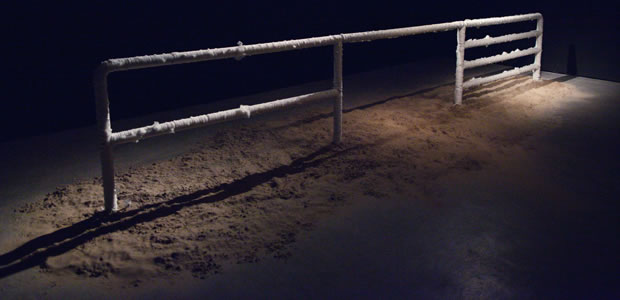
LEAD ARTIST: SEAMUS NOLAN (IE)
ARTISTS: PHOEBE DICK (IE) EMMA HOULIHAN (IE) LILIANA PISKORSKA (PL) DAGMARA POCHYŁA (PL)
Locis is premised on the idea that there are no expectations to produce. The process is one of exchange and informality, of research and collaboration.
No demands to produce anything other than the formalities or commonalities of arts production, recognized here as enacting the visit, the research, the hospitality, the connections, the statement, the image, the publication, the text, the advertisement, the exhibition, the seminar, the banquet and the after party…
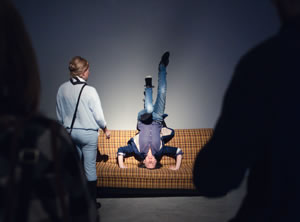 The immaterial artwork recognized in the signifier’s of its materiality, utilizes the materiality of context, and in this case the project becomes an opportunity to display, and or to commandeer a host of sites upon which meaning may be produced. In this realm of inquiry the artwork might exist beyond the gallery, in an expanded field of activity, which acknowledges the indeterminability of the artwork and the support, which this kind of work requires in order to develop.
The immaterial artwork recognized in the signifier’s of its materiality, utilizes the materiality of context, and in this case the project becomes an opportunity to display, and or to commandeer a host of sites upon which meaning may be produced. In this realm of inquiry the artwork might exist beyond the gallery, in an expanded field of activity, which acknowledges the indeterminability of the artwork and the support, which this kind of work requires in order to develop.
Funded by the EU cultural programme and selected by the participating cultural centres our work and ideas somehow represent what is acceptable as artworks, ideas which are concurrent with existing cultural practice, we have been presented with the opportunity to represent contemporary European culture.
The nature of the project is premised on the exchange, the process of inquiry, of friendship and of critique, with a secondary objective to present work in the gallery.
At what point is the informal process of inquiry and exchange formalized and constituted as an effective model for producing informality. In a sense the outcome of the project has been defined in its guidelines, yet these same guidelines constitute a model for developing a practice beyond the confines of traditional research and development.
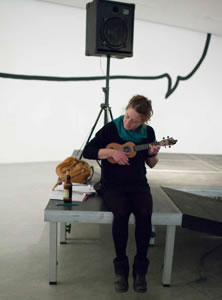 Working, as we have been, in a reflexive and reciprocal manner, facilitating criticality in terms of the development of the work, the context of its production and the site of its presentation. Similarly considering an outcome, the artwork may or may not exist but should engage the artist and his or her chosen audience in a dynamic of mutual antagonism, to make new a visually performative or process-based interrogation of the form and subject, the specific conditions of the individual arts practice, and the complexities and contradictions of its manifestation as a work of art.
Working, as we have been, in a reflexive and reciprocal manner, facilitating criticality in terms of the development of the work, the context of its production and the site of its presentation. Similarly considering an outcome, the artwork may or may not exist but should engage the artist and his or her chosen audience in a dynamic of mutual antagonism, to make new a visually performative or process-based interrogation of the form and subject, the specific conditions of the individual arts practice, and the complexities and contradictions of its manifestation as a work of art.
The polemic, which exists in making work that is critically engaged, where the subject reflects the problematics of the institutional framework or seeks to represent the marginal within this framework, is the ability of the institution to absorb its own critique. The issue of cultural authority and validation whereby the gallery enacts the role of Andrea Fraser, has questioned her own work which is renowned as a model of institutional critique, in asking why the gallery would ask her to make work which is critical of their process if they thought it would make any difference.
The impetus to create new, to move beyond the artist studio and the gallery and to lend institutional support to the process of engagement, which the artist pursues, rather than the object of its representation, speaks of a desire to reassess the role of art in society. If occupying the gallery is secondary to the process of producing work then we are left with the problem of how and why the artwork must be represented other than to justify funding and fulfil its contract of immediate social or political engagement.
All activity is not art, and all art is not activity.
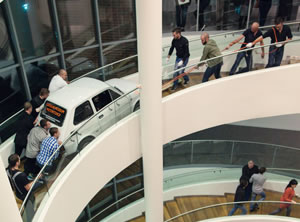 Giorgio Agamben points to the immaterial artwork when he asserts that the artwork is a false confrontation between the idea of creativity and labour, citing the artists role as one of justifying ones existence beyond the dynamic of labour and exchange. Asserting that existence does not require justification, either through work or through production; the artist’s role is to define the purpose of his or her own existence.
Giorgio Agamben points to the immaterial artwork when he asserts that the artwork is a false confrontation between the idea of creativity and labour, citing the artists role as one of justifying ones existence beyond the dynamic of labour and exchange. Asserting that existence does not require justification, either through work or through production; the artist’s role is to define the purpose of his or her own existence.
The idea of acquiring funding to pursue a process of exchange without any foreseeable outcome reminds us of J.rg Schr.der’s advertising agency Bismarc Media, whose employees were told to produce nothing, and when they couldn’t bear producing nothing, observe each other labouring under the pointless compulsion to be productive. A general manager was appointed whose task was to undermine any possible output.
Is the goal of the project to reject the artwork and champion the process? No, but if the goal of the project is to develop new models of exchange and ways of making work, the challenge then is to infuse these elements of production and instigate artworks as process, ethereal models of exchange materialised in order to disappear Embodying the tensions of these contradictions in the sites of contact between the gallery, the artist, the audience, and the subject.
Enter quickly, as I am afraid of my happiness
“Enter quickly, as I am afraid of my happiness” (2000:123). Derrida explains: As if, then, the stranger could save the master and liberate the power of his host; it’s as if the master, qua master, were prisoner of his place and his power, of his ipseity, of his subjectivity (his subjectivity is hostage). So it is indeed the master, the one who invites, the inviting guest, who become the hostage – and who really always has been. And the guest, the invited hostage, becomes the one who invites the one who invites, the master of the host. The guest becomes the host’s host. The guest (h.te) becomes the host (h.te) of the host (h.te). (2000: 123-25) (Chin-yuan Hu 2013)
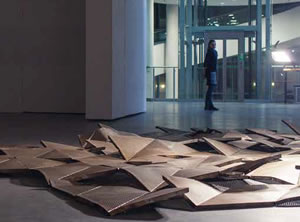 Jacques Derrida speaks of the anxiety around the loss of self in accepting otherness, playing with the notion of hospitality as conditional in terms of the host guest relationship or unconditional hospitality in terms of truly accepting otherness. The possibility of the host becoming the guest or the guest becoming the hosts host relates to this underlying acceptance of the other and the possibility of change occurring within the encounter. This statement becomes a device to make explicit and forego the conditional and offers a level playing field where both host and guest might meet as equals.
Jacques Derrida speaks of the anxiety around the loss of self in accepting otherness, playing with the notion of hospitality as conditional in terms of the host guest relationship or unconditional hospitality in terms of truly accepting otherness. The possibility of the host becoming the guest or the guest becoming the hosts host relates to this underlying acceptance of the other and the possibility of change occurring within the encounter. This statement becomes a device to make explicit and forego the conditional and offers a level playing field where both host and guest might meet as equals.
The works presented as part of the Locis project are premised on the notion that change is both possible and desirable, the works seek to transform, transcend or transgress distinctions between the ideas of artist and activist, audience and performer, protagonist and subject. Interrogating the spaces of collective behaviour in order to instigate or infer alternative narratives within these relationships. The gallery becomes a site for engagement but a site among sites, for the works are situated within public and collective spaces as much as private and individual space.
The gallery operates as an armature, which might support the activities of the individual artists, playing host to these diverse practices from varied cultural and social backgrounds. Fluctuating between host and guest, between conditional and unconditional. Informing meaning and identity in processes of positioning and disposition.
Phoebe Dick plays with notions of performer and performance, offering a platform for exchange through the act of participation; the viewer is invited to perform for the staff in the front of the house in exchange for a ticket to enter the show. Activating the object(s) and process of engagement through the mechanics of exhibition, performance and reciprocation.
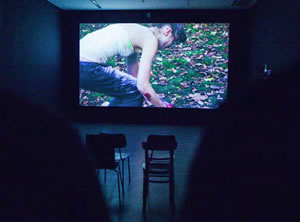 Liliana Piskorska invites the staff, board of CoCA, and audience, to reconsider the objectives of the cultural centre and opens a dialog around issues of gender and identity politics within the framework of the gallery programme. Advocating for a social as well as a cultural responsibility towards the artist and the artwork, reflecting on notions that institutionalized public legal entities have the ability to shape social thinking.
Liliana Piskorska invites the staff, board of CoCA, and audience, to reconsider the objectives of the cultural centre and opens a dialog around issues of gender and identity politics within the framework of the gallery programme. Advocating for a social as well as a cultural responsibility towards the artist and the artwork, reflecting on notions that institutionalized public legal entities have the ability to shape social thinking.
Dagmara Pochyła reflects upon the collective, and brings everyday public structures into the gallery as objects of monumental positionality. These sites of memory and collective identity formation destabilise the notion of shared meaning in history and ideology, these recalcitrant objects refuse appropriation and offer the viewer an opportunity to renegotiate memory in the present.
Emma Houlihan fluctuates between protagonist and antagonist, reading the city and its potential for transformation. A series of actions exist within the city and gallery, interactions and interventions, which crystalize the incidental moment in an expanding process of enquiry.
Seamus Nolan sets in motion a project to remake the discarded relief panels of two little known Polish artists J.zef Murlewski and Czesław Woźniak, the designers of the ornamental relief panels of the Children’s building in Toruń. These interior panels were recently destroyed to make way for the refurbishment of the buildings new identity as a Pizza Hut, although the exterior of the building has been preserved as a protected structure under the UNESCO heritage city guidelines.
My practice investigates the relative value of objects and social processes as they appear within different economies and contexts. In my work, I try to unravel the commonplace, to recognise the inherent structure or code from which we, as social and political animals construct and de-construct the world around us. My work is concerned with power relations, energy and possibility; I am interested in reconfiguring the everyday as a means to examine or question the purveyors of meaning.
Phoebe Dick lives in Manorhamilton in the north-west of Ireland, less than an hour from where she grew up. Phoebe’s connection to physical and social surroundings emerges in work that evidences a keen eye and appreciation for the wider world, and this particular region, with an acute awareness of some of the problems faced within it.
A love of complex systems, chaos and fractals, informs Phoebe’s worldview, and her creative process is often a mathematicians quest to discover simple transferrable truths, similarities, or patterns in the world. What Phoebe percieves or percieves to be possible in her surroundings is reduced or expanded, expounded on, and made public in various media, with printmaking and songwriting forming the foundations of a diverse practice.
A desire to creatively engage with her environment beyond her personal practice led to Phoebe’s involvement in the development and management of a “creative community space” and guesthouse in Manorhamilton, where a platform is provided for various social and creative activities and Phoebe’s faith in chaos is put to the test.
Toruń Główny, 5 minutes shy, I seek out the wait. The train station is under construction, the waiting room, like most waiting rooms, feels wrong – neither cosy nor conducive to conversation. I wander, waiting for what I don’t know. I circle main arrivals and departures, the morning light flooding in, god fingers illuminating Romuald Drzewiecki’s ceiling above – sparkling in the morning sun – a dream of fool’s gold.
What is a waiting room? A repository for those who are anticipating arrival or passing time in advance of departure, or a purgatory for those gathered together in a common limbo? What is a storage space, a statue park or a gallery? A container, a vessel for objects. Objects that if arranged together have the potential to create new meanings. Trains never leave, but depart. They never reach their destination, but terminate. The end of the line. Yet, nothing is permanent, everything is temporary. Change is constant. Can a collection of obtuse triangles come full circle and transform into an object of good – a pseudo dodecahedron to mimic a fool’s gold? Only time will tell if one can begin from the beginning again and reinvent the good parts.
I am a non-heterosexual artist living and working in Poland. I am staining the city with myself. In my work I am talking about being seen in the public space and seeing others in the public space. My work concerns visibility and visualization of visibility. I am playing with my openness; I want to bring myself closer to the landscape, my home district and my community. There is a state of longing. I am longing to become a member of a community. An art institution legitimizes my activism, my activities, and the institution legitimizes me as an artist and so it also legitimizes me as a person. It gives me credibility. But could the institution, by standing behind my artwork, legitimize my presence in a society? Art and culture should be an area of freedom and equality, a place to present Utopian social and political images.
In my work I am staining the landscape. I am pressuring you to choose a side, I am asking you to verbalize an opinion and to make a statement of your own.
I spent my childhood surrounded by pinewoods, modernist architecture of the University of Nicolaus Copernicus and typical blocks of flats. I never gave a thought about becoming an artist;, I was always more into biology, animals and nature. The decision to study art was sudden and unexpected. I graduated from the Faculty of Fine Arts at the Nicolaus Copernicus University in Toruń, specializing in the Intermedia Art in 2007. My diploma work was an interactive video installation entitled Being of projectionn projection of being and it has been presented in various exhibitions in Warsaw, Klenovy (Czech Republic) and Torun. In my works I use mostly video, installation and performance media. In the beginning I focused mainly on new technologies and new media, and their influence on the form s of interpersonal communication as well as the intrinsic nature of these changes. The performance actions raised questions of the relation between the individual and an intuitively perceived unity of the world, the interdependence of entities. My work also deals with topics of parallelism and duality within the individual, distortions of the space and time perception, and attempts to of captureing the “in-between” states. I’m currently moving within the mottos of post-humanism, where I examine the relationship between nature and culture.